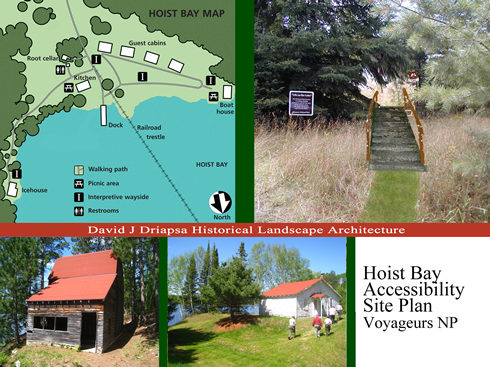
Hoist Bay
Voyageurs National Park, Minnesota
U.S. National Park Service
The General Management Plan for Voyageurs National Park written in 2002 included the development of 15-20 visitor destinations. These destinations can be reached only by boat and provide visitors with an opportunity to learn about this national park and its significance.
David Driapsa master planned boat docks, accessible trails, picnic facilities and interpretive wayfinding exhibits for these destinations that include historic structures and cultural landscapes being preserved by the National Park Service.
This project meets the provisions of Sections 106 and 110b of the National Historic Preservation Act, requiring federal agencies to produce documentation to HALS standards on sites that are listed in the National Register of Historic Places to mitigate the adverse effects of federal actions such as demolition or substantial alteration.
The work was conducted by David Driapsa serving as project director for Voyageurs National Park Division of Resources Management. He prepared master plans for numerous historic sites in the park, including Hoist Bay. Each master plan includes an ADA accessible boat dock, path, comfort station, picnic tables, fire rings and interpretative signage. David compiled archival information and site reconnaissance documenting the existing historic landscape, architectural and archeological resources and developed the master plan document. The site is accessible by water.
The master plan assesses existing natural and cultural resources and recommends site organization to enhance visitor
experience, interpretation, and programming. Management of resources and ADA accessibility are critical issues
that are addressed, presenting present short- and long-term goals by which the Park Service can meet both goals of
accessibility and preservation.
The property was a log hoist facility for the Virginia & Rainy Lake Lumber Company. Piers of the former railroad trestle are still visible from the logging period. Ted and Fern Monson acquired the property in 1938 and spent the first few years clearing remains of the lumber camp and building rental cabins for a resort that operated until 1973.